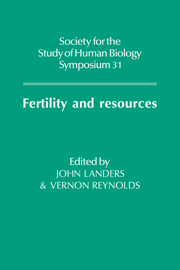Book contents
- Frontmatter
- Contents
- List of contributors
- 1 Introduction
- 2 Environmental and social determinants of fecundity in primates
- 3 Biological aspects of fertility among Third World populations
- 4 A preliminary report on fertility and socio-economic changes in two Papua New Guinea communities
- 5 The cultural context of fertility transition in immigrant Mennonites
- 6 Inter-relationships between consanguinity, religion and fertility in Karnataka, South India
- 7 Resources and the fertility transition in the countryside of England and Wales
- 8 Fertility decline and birth spacing among London Quakers
- 9 Population growth, innovation and resource exploitation
- 10 Fertility decline in developing countries: the roles of economic modernization, culture and Government interventions
- 11 Understanding recent fertility trends in the Third World
- 12 Monogamy, landed property and demographic regimes in pre-industrial Europe: regional contrasts and temporal stabilities
- Index
10 - Fertility decline in developing countries: the roles of economic modernization, culture and Government interventions
Published online by Cambridge University Press: 13 March 2010
- Frontmatter
- Contents
- List of contributors
- 1 Introduction
- 2 Environmental and social determinants of fecundity in primates
- 3 Biological aspects of fertility among Third World populations
- 4 A preliminary report on fertility and socio-economic changes in two Papua New Guinea communities
- 5 The cultural context of fertility transition in immigrant Mennonites
- 6 Inter-relationships between consanguinity, religion and fertility in Karnataka, South India
- 7 Resources and the fertility transition in the countryside of England and Wales
- 8 Fertility decline and birth spacing among London Quakers
- 9 Population growth, innovation and resource exploitation
- 10 Fertility decline in developing countries: the roles of economic modernization, culture and Government interventions
- 11 Understanding recent fertility trends in the Third World
- 12 Monogamy, landed property and demographic regimes in pre-industrial Europe: regional contrasts and temporal stabilities
- Index
Summary
Introduction
As described by Allan Hill in this volume, the last twenty years have witnessed spectacular declines in human fertility. In 1970, birth rates were high and showed little sign of change in any major developing region of the world. The few exceptions were clearly idiosyncratic, comprising small island states such as Fiji and Mauritius, the city-states of Hong Kong and Singapore and larger territories that had received massive North American aid, as in the case of the Republic of Korea and Taiwan.
Some twenty years later the position is very different. Fertility has declined throughout Central and South America and appears to be approaching replacement level in such countries as Brazil. In Asia, there is greater variation in recent trends. Steep declines have occurred in China, Indonesia and Thailand. More modest falls have been registered in Malaysia, the Philippines, Vietnam and India. In Bangladesh there is recent evidence of a moderate decline, while in Pakistan fertility may even have risen.
In the predominantly Arabic belt of North Africa and the Middle-East, birth rates remain high but downward trends are well established in Egypt and Tunisia and there have been more recent falls in Morocco and Algeria. Similarly, in sub-Saharan Africa, high fertility persists and several countries have experienced a rise rather than a fall over recent decades. Zimbabwe and Botswana are the only countries in this region with unmistakeable trends to lower fertility, but Kenya is about to join their ranks.
Attempts to account for these trends are dominated by economic considerations. Esther Boserup has presented in this volume many of the central arguments.
- Type
- Chapter
- Information
- Fertility and Resources , pp. 126 - 145Publisher: Cambridge University PressPrint publication year: 1990
- 6
- Cited by

